
Osteochondrosis is rightly considered a "disease of the century" today, because it most often affects people whose work does not require increased physical activity.
In most cases, changes in cartilage and bone tissue are observed in people of working age - up to 40 years.
The disease can affect different parts of the spine, and the second most common is osteochondrosis of the cervical spine.
What is it?
Osteochondrosis is a degenerative disorder of articular cartilage and adjacent bone tissue.
Previously, the term was applied to a large group of osteoarticular diseases, but is now used only for degenerative diseases of the spine.
Compared to other parts of the spine, the cervical region is the most mobile and has many nerve and vascular formations. The structure of the vertebrae is small in size, as is the fact that they are surrounded by a rather weak muscular corset.
This anatomical structure predisposes to the development of osteochondrosis, the severity of clinical manifestations of which depends on the nature of the changes in the intervertebral discs and the degree of their destruction.
Reasons for developing the disease
The main and most common cause of osteochondrosis of the cervical spine is a sedentary lifestyle.
Due to lack of physical activity with inactive and inactive lifestyle:
- metabolic processes are disturbed;
- increases the level of salt in the bloodstream and lymph fluid;
- Salts are deposited in the cervical spine, kidneys and liver.
Damage to the cervical spine is mainly caused by a lack of nutrients in the intervertebral discs. Therefore, the main reasons for the appearance of cervical osteochondrosis include improper and unbalanced diet.
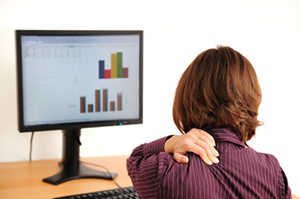
Risk factors
There are many risk factors for cervical osteochondrosis.
The most common factors are:
- heredity;
- age changes;
- cervical spine injuries;
- hypothermia;
- hormonal disorders leading to metabolic disorders;
- some autoimmune diseases that damage cartilage tissue (systemic lupus erythematosus, rheumatism).
Why is it dangerous?
Not only the spinal cord and nerve roots pass through the cervical spine, but also the spinal artery, which is responsible for supplying blood to the back of the brain, the medulla oblongata and the cerebellum.
Therefore, in cervical osteochondrosis, this artery constricts, resulting in impaired cerebral circulation.
In extremely advanced cases, compression of an artery and adjacent blood vessels and nerve plexuses can lead to such consequences as:
- lack of coordination;
- hearing and vision loss;
- stroke.
If the disease is not cured in the initial stage, it can lead to such complications as: protrusion of the intervertebral disc or herniated disc.
Disease progression
Cervical osteochondrosis, like osteochondrosis of other parts of the spine, develops in stages. There are 3 stages of disease development.
1 degree
It is characterized by the onset of destruction of intervertebral discs.
In annular fibrosus, cracks appear, the strength and elasticity of the disc are disturbed, its height decreases, due to which the nerve roots compress.
Characteristic excruciating pain occurs. Sometimes in stage 1 (preclinical) such pain may be absent and osteochondrosis passes with moderate discomfort in the neck.
2nd degree
If grade 1 osteochondrosis has not been treated or treatment has not been effective, then a chronic condition, or grade 2 osteochondrosis, occurs.
The pain becomes constant, destruction and compaction of the intervertebral disc continues and leads to minor dislocations of the cervical spine.
With cervical osteochondrosis at this stage, a head fall syndrome may develop. This syndrome is characterized by severe pain, and the person must keep their head in a fixed position to reduce the pain.
3rd degree
Grade 3 cervical osteochondrosis is accompanied by the following symptoms:
- headaches;
- nausea;
- dizziness;
- neck "lumbago";
- impaired sensitivity of the upper limbs.
The fibrosus ring is almost destroyed, which leads to complications of osteochondrosis - protrusion of the intervertebral disc or intervertebral hernia.
In stage 3 osteochondrosis, the intensity of pain may be reduced because the affected cartilaginous tissue in the intervertebral disc simply does not exist, meaning there is no source of pain, but pinching of nerve roots remains, so the pain does not disappear completely.
Signs and symptoms
There are many signs of this disease. And they depend on which vertebrae are damaged by this disease.
Typical cervical osteochondrosis syndromes are:
- radicular syndrome;
- spinal artery syndrome;
- cervical migraine syndrome;
- hypertensive syndrome.
All of these syndromes are primarily accompanied by different types of pain.

If we take into account the syndrome of the spinal artery, then the headache here is manifested at an early stage of the disease.
In this case, pain attacks can be monitored:
- dizziness;
- unsteady gait;
- visual symptoms (appearance of fog in front of the eyes, decreased visual acuity, etc. ). fainting (with sudden movements of the head).
In hypertensive syndrome, elevated intracranial pressure is determined.
The headache is more of a shooting character, it can be accompanied by nausea and vomiting. With exacerbation of cervical osteochondrosis, an increase in temperature and an increase in ESR may be observed.
When the spinal roots are compressed ("radicular syndrome"), the following neurological symptoms may occur:
- severe neck pain (cervicalgia);
- neck pain that spreads to the forearm and upper arm bone (cervicobrachialgia);
- pain in hand;
- shooting or shooting in the neck when turning the head;
- pain that "radiates" to the ear, and occurs most often after a long stay in an uncomfortable position or sudden movement;
- pain or feeling of a lump in the throat, breathing problems;
- numbness of hands and tongue;
- feeling of swelling of the tongue;
- severe weakness;
- hearing and vision impairment;
- tinnitus;
- general deterioration of health.
In the syndrome of "cervical migraine", irritation of the sympathetic nodes is noticed, which leads to a disorder of the reactivity of the cerebral vessels and damage to the blood circulation.
As a result, hypertension can develop, often accompanied by:
- clogged ears;
- tachycardia;
- noise in the head;
- rings in my ears.
When the arteries that supply the spinal cord are constricted, a stroke can occur.
Violation of blood circulation in the brain with osteochondrosis can lead to:
- lack of oxygen in brain cells;
- mental disorders (depression, panic attacks);
- signs of epilepsy, such as short-term loss of consciousness and whole-body tension - are often confused with signs of epilepsy.
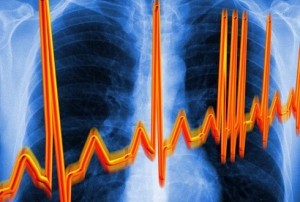
A very common sign of cervical osteochondrosis are changes and disturbances in heart rhythm, for example, extrasystoles or arrhythmias.
These symptoms are very common among drivers and office workers.
Due to an inactive lifestyle, changes occur on the intervertebral discs of the cervical and thoracic spine, which leads to heart disorders.
In most cases, until osteochondrosis is cured, it is almost impossible to get rid of the heart rhythm disorder.
Edema under the eyes may also indicate osteochondrosis of the cervical spine.
They usually depend on the position of the head during a night's sleep, disappear during the day and are combined with headache, dizziness, heaviness in the head, etc.
Vegetovascular dystonia is another common disease that occurs with this disease.
It is a consequence of the constriction of the vascular arteries that extend along the lateral sides of the spinal column.
Diagnostic Methods
The preliminary diagnosis is made by a neurologist during the initial examination of the patient. More recently, the doctor has had to make a diagnosis by performing only an external examination of the patient and sending him for an X-ray.
But, unfortunately, it is impossible to see the full picture of the development of the disease on X-ray.
Currently available examinations such as computed tomography and magnetic resonance imaging, with which you can fully assess the stage of disease development.
After diagnosis, the patient is referred to a physician who specializes in the area.
Which doctor treats?
The treatment is performed by a narrow-focus specialist - a vertebrologist or a vertebroneurologist.
Treatment of cervical osteochondrosis
The severity of the main clinical symptoms is taken as the basis for the treatment of cervical osteochondrosis.
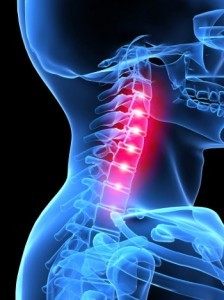
In the cervical spine, symptoms are mainly related to constriction of blood vessels and nerve endings, so during treatment they primarily remove edema and restore blood circulation.
There are many treatment methods used in the treatment of cervical osteochondrosis.
The most effective treatment is complex, which is a combination of several conservative treatment methods.
Complex treatment of cervical osteochondrosis can include the following traditional and non-traditional methods: drug treatment, massage, acupressure, manual therapy, physiotherapy, acupuncture, homeopathy, folk remedies, etc.
The main stages of treatment of osteochondrosis are the same for all localizations of this disease:
- You need to ease the pain first.
- Then the edema will be removed.
- At this stage it is necessary to normalize blood circulation.
- Strengthen muscle corsets.
- Improving nutrition and tissue regeneration.
Only a team of good professionals can choose the most appropriate therapy, which includes a neurologist, physiotherapist, massage therapist, surgeon and vertebral neurologist.
Like any disease, cervical osteochondrosis should be treated at the earliest stage of its onset. If you do not start the procedure, you can achieve a complete cure of osteochondrosis at this stage.
Unfortunately, stages 2 and 3 of cervical osteochondrosis are accompanied by complete or partial destruction of the intervertebral discs, so these stages are characterized by a very long recovery process.
First Aid
How to relieve pain during exacerbation?
In case of severe pain, it is necessary to take a painkiller from the home clinic: these can be analgesics. You can also apply pepper plaster for pain.
In case of swelling, diuretics may be taken. Rubbing your neck with pain relieving ointment can help.
You can also use theneedle applicatorfor pain, which:
- relieves back pain;
- reduces muscle spasm;
- stimulates the work of internal organs;
- normalizes blood circulation.
Physiotherapy in exacerbations is contraindicated, as is warming, as these effects can cause serious complications.
After relieving acute pain, seek medical advice immediately.
Drug treatment
Drug treatment usually begins with injections (in case of exacerbation) and then switches to tablets and suppositories in combination with topical application of ointments and gels.
Anesthesia during drug treatment is performed with steroidal anti-inflammatory drugs.
Medications that restore cerebral circulation must be prescribed.
Muscle relaxants may be prescribed for pathological muscle tension. For more effective treatment, vitamins are taken in therapeutic doses and trace elements.
In cases of intervertebral hernia, surgery is often recommended, and the attending physician may suggest surgery.
Massage and self-massage
This method works well with physical therapy and physiotherapy. You can attend a massage course in any medical institution and by contacting private practices.
Massage is needed for cervical osteochondrosis to strengthen muscles and relieve tension in the neck.
The task of the masseur is to remove harmful metabolic products by increasing the outflow and inflow of blood into the diseased area, as well as to remove cramps from the pathological area.
The main techniques used by neck massage experts are:
- caressing;
- squeeze;
- rubbing;
- vibration;
- kneading.
The self-massage technique can be performed using the following techniques:
- smoothing (movements should be soft, without much effort, forming folds)
- kneading (deep impact on muscles, by gripping the crease, pressing and pushing);
- vibrations (vibrational shocks by hitting, shaking, tapping).
Self-massage should always end with a caress. You can use a massager during vibrations.
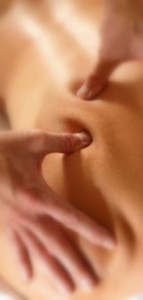
Acupressure massage
Acupressure massage relieves headaches well with worsening of cervical osteochondrosis, helps with pressure surges, normalizing it.
Acupressure scheme:
- Effect on the feng fu point, located below the occipital bulge, for 1 minute.
- Influence on the feng chi point, located two fingers wide from the mastoid adults of the skull.
- Impact 1-1, 5 minutes on the ya-men point (located at a distance of three fingers from the feng fu point).
- Sedation 1-1, 5 minutes at da-chzhui point (7th cervical spine).
After acupressure you should lie down for a few minutes as you may feel a slight dizziness.
Manual therapy
Manual therapy helps to cope with acute and chronic pain, also increases range of motion and improves posture well.
Main methods of manual therapy of cervical osteochondrosis:
- Relaxing and segmental massage.Used to warm up muscles and relieve tension.
- Mobilization.Influences aimed at restoring joint function by traction.
- Manipulation.Sharp thrust directed at the patient's pathological areas. The procedure is followed by a characteristic crunch (return of the joint to a normal position).
A specialist in manual therapy should be fluent in these techniques. Otherwise, any mistake can lead to injury.

Acupuncture
Acupuncture promotes the release of cortisol into the bloodstream. This hormone has a pronounced anti-inflammatory effect.
Acupuncture is performed by acting on points near the inner edge of the scapula. The needles are inserted to a depth of 1 to 2 cm and left to act for 10 to 30 minutes.
Homeopathy
Drug treatment carries with it many unwanted side effects, so homeopathy can be a worthy substitute for treatment without side effects.
Nutritional Features
Foods should be rich in calcium and magnesium.
These trace minerals are found in fish and seafood, nuts, legumes and dairy products.
Often osteochondrosis of the neck can be accompanied by atherosclerosis. In this case, a strict diet is recommended.
The diet is prescribed for 3-4 months. It is necessary to limit the consumption of all foods that contain cholesterol. These include animal fats, fatty meats, fatty dairy products, etc. You should also limit or exclude the consumption of salt, sugar, flour products.
It is recommended to quit bad habits (smoking, alcohol, etc. ).
Cervical osteochondrosis and alcohol are interrelated. The fact is that the alcohol entering the blood destroys the cells, and thus worsens the already disturbed blood circulation in osteochondrosis.
Therefore, you should limit it to a minimum and stop drinking alcohol completely during exacerbations.
Disease Prevention
To prevent cervical osteochondrosis, it is recommended to follow these rules:
- sleep should be on a firm mattress and on a low pillow: the bending angle of the door should not exceed 15 degrees;
- take a hot shower every day for at least 10 minutes;
- visit the sauna and bath as often as possible: heat helps relieve neck cramps;
- Treat yourself to aerobic activities and regular walks at a slow pace;
- to swim;
- after 25 years, avoid impact load on the spine (jumping, running);
- When working inactive, be sure to take five-minute breaks every hour;
- regular yoga practice can prevent any manifestations of cervical osteochondrosis;
- refrain from going to the gym, because bodybuilding can cause a protrusion of the cervical disc;
- physical exercises as prophylaxis against osteochondrosis of the neck help to strengthen the neck muscles, relieve tension.
Frequently Asked Questions
What to do during pregnancy and how to treat it?
The first symptoms of cervical osteochondrosis often appear during pregnancy.
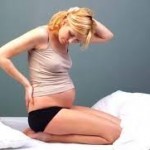
This is due to changes in hormonal levels and softening of the spine, as well as due to shifting of the center of gravity and excessive stress on the spine.
The treatment of osteochondrosis in pregnant women is quite complex, as it is mostly limited by the method of medication aimed at relieving pain.
You can apply natural ointments or resort to traditional medicine.
Any impact on the neck area (warming up, exercise, etc. ) during pregnancy is strictly forbidden.
Does this happen in children and adolescents?
In children and adolescents, cervical osteochondrosis develops as a result of congenital or acquired functional insufficiency of cartilage tissue.
Expresses complaints of headache, fatigue, dizziness and fainting.
Can the door area be heated?
Warming the neck with cervical osteochondrosis is strictly forbidden, especially in the phase of worsening the disease, because heating can lead to increased edema and vasodilation of the brain.

How to sleep properly?
Sleep on a flat, hard bed with an orthopedic mattress.
The recommended and most comfortable position is lying on your side, shoulder resting on the mattress and head resting on a small pillow.
The use of an orthopedic pillow helps to relax the muscles of the cervical spine, reduces irritation of nerve endings, which prevents headaches and insomnia.
Are physical activities and sauna allowed?
In preventive measures and in the 1st phase of cervical osteochondrosis, it is recommended to engage in physiotherapy exercises, swimming.
Weightlifting, hard work, training in gyms is strictly forbidden.
A visit to the spa and sauna is also recommended only for the prevention of cervical osteochondrosis and in the initial stage of the disease.
Reviews
"I would like to share with my brothers the misfortune of how to deal with cervical osteochondrosis. A couple of years ago I had back pain. A visit to the doctor, the diagnosis was cervical osteochondrosis. Many things have been tried out of treatment: physiotherapy, manual therapy and massage. But there was always only temporary relief, besides, these are all very expensive procedures. I had to start studying the problem thoroughly. That's why I decided to try swimming. It turned out that swimming is widely used to prevent and treat cervical osteochondrosis because it extremely relieves tensionneck muscles. once a week in the pool and sadness I do not know. "
"Due to overwork I could not find time to see a doctor. And my relatives advised me to treat neck pain with warming, herbal compresses, ointments in various ways and other home remedies. that the neck stopped moving at all! I was lying at homemore than two weeks, and even then it took a long time to recover. So my advice to everyone is to see a doctor as soon as your neck tightens and hurts! This will save you time and not lose your health. "

























